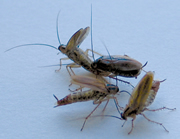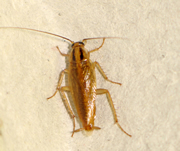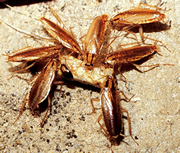German cockroach (Blattella germanica)
 German cockroach |
| Image source: Benoit Guénard |
The Blattella germanica genome sequence and its analysis has been published. The article, "Hemimetabolous genomes reveal molecular basis of termite eusociality," is available from Nature Ecology & Evolution.
We at the BCM-HGSC would like to thank the many members of the Blattella community whose hard work has made this a successful project.
Contact: Erich Bornberg-Bauer
Researchers involved: Xavier Belles, Erich Bornberg-Bauer, Ameya Gondhalekar, Judith Korb, Dmitry V. Mukha, Maria-Dolors Piulachs, Coby Schal Michael E. Scharf, Ayako Wada-Katsumata, and Guillem Ylla
Size (or size of nearest relative): 1.96 GBp
Keywords (and why important): Human and animal health, insecticide resistance, chemical communication, social behavior, phylogenetic position, RNAi, Evo-Devo, public interest
 Cockroaches. Cockroaches were so plentiful in the Carboniferous period that this late Paleozoic era is sometimes referred to as “The Age of Cockroaches.”
Cockroaches. Cockroaches were so plentiful in the Carboniferous period that this late Paleozoic era is sometimes referred to as “The Age of Cockroaches.”
There are about 4,500 species of cockroaches in 515 genera, but many more remain to be named. The genus Blattella contains 51 species.
In the 375 years since its original description, the German cockroach has had 23 scientific names, including several in the genera Blatta, Ectobius, Phyllodromia, Ischnoptera, and Eublattella.
Blattella asahinai (Asian cockroach) is most closely related to B. germanica and in the laboratory the two hybridize and produce viable offspring. The German cockroach likely originated in Southeast Asia, the center of diversity of the genus Blattella.
Cockroaches serve as important models in studies of endocrinology and development of hemimetabolous insects, insecticide resistance, chemical communication, and neurobiology. Life history. The German cockroach is strictly synanthropic, inhabiting human-made structures, including livestock structures, homes, apartments, supermarkets, food processing plants, restaurants, and ships; it has a world-wide distribution.
Life history. The German cockroach is strictly synanthropic, inhabiting human-made structures, including livestock structures, homes, apartments, supermarkets, food processing plants, restaurants, and ships; it has a world-wide distribution.
A key evolutionary innovation of the German cockroach that presumably contributed to its success as an indoor pest is retention of the egg case by the female throughout the period of embryo development, until the 40 eggs hatch 21 days after oviposition.
Nymphal development proceeds rapidly in the German cockroach. Males and females undergo 6 molts but males emerge as adults earlier than females, in about 35 days. Cockroaches raised in groups complete their development faster than nymphs raised in isolation. Chemical ecology. Nymphs and adults produce aggregation pheromones consisting of attractant and arrestant components.
Chemical ecology. Nymphs and adults produce aggregation pheromones consisting of attractant and arrestant components.
Virgin females produce a volatile sex pheromone, blattellaquinone, which attracts males from a distance, and a six-component contact sex pheromone that stimulates males to court the female.
Males also produce volatile attractants, feeding stimulants and a nuptial gift in a specialized tergal gland. Medical and economic importance. The economic consequences of German cockroach infestations can be significant, especially in hotels, restaurants, supermarkets, and cruise ships. Cockroaches damage food, dishes, packaging, clothing, and furniture and leave behind excrements and foul odors. They also can short-circuit electronics and chew through wiring.
Medical and economic importance. The economic consequences of German cockroach infestations can be significant, especially in hotels, restaurants, supermarkets, and cruise ships. Cockroaches damage food, dishes, packaging, clothing, and furniture and leave behind excrements and foul odors. They also can short-circuit electronics and chew through wiring.
The German cockroach is a major public health pest because it is a major source of allergens and a major cause of asthma morbidity, especially in inner-city homes. It also mechanically transmits pathogenic microorganisms including viruses, helminthes, fungi, protozoa, and bacteria, including antibiotic resistant strains; German cockroach infestations can be severe in livestock facilities.
Because German cockroach populations are frequently controlled with broad-spectrum insecticides, and many populations have high levels of insecticide reistance, large amounts of insecticide are used against cockroaches, resulting in extensive indoor exposures to pesticides.
Genome. A fully sequenced genome will be useful in phylogenetic studies; comparative studies of the evolution of sociality; provide markers for population and phylogeographic studies; identify developmental and other genes in a primitive insect; reveal potentially allergenic proteins; help understand mechanisms of insecticide resistance; identify endocrine pathways; understand how the nervous system develops and functions; reveal unusual mutualistic and pathogenic relationships with microbes; and identify new and cockcroach-specific targets for pest control.
Images in the above article provided by: Coby Schal
Genomic Resources
For the most current version of the assembly, please use 'NCBI BioProject' (find link below). If the assembly is unavailable in the BioProject page (it is still being worked on), you can look under the 'BCM-HGSC data' (find link below) for intermediate versions of the assembly.
Web Apollo: A web-based sequence annotation editor for community annotation
For information about Web Apollo, please contact Monica Poelchau.
-
Web Apollo annotation tool (requires log in)
-
Web Apollo Jbrowse viewing of the automated annotation tracks (no log in required)